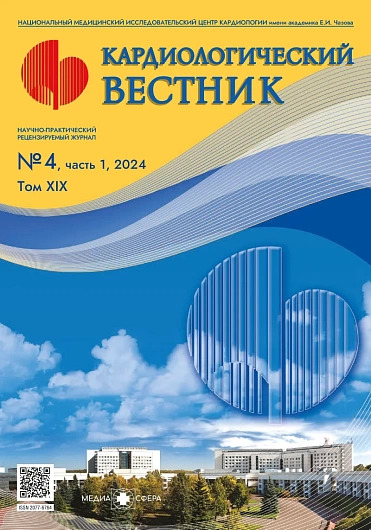Prediction of no-reflow phenomenon in endovascular treatment of patients with acute ST segment elevation myocardial infarction
Abstract
No-reflow phenomenon is common in patients with ST-segment elevation myocardial infarction (STEMI) undergoing coronary artery stenting. There is still no generally accepted risk stratification model for these patients.
Objective. To identify predictors and regression model for no-reflow phenomenon in patients with STEMI.
Material and methods. A retrospective study included 143 STEMI patients who underwent infarct-related artery stenting. We estimated predictors of no-reflow phenomenon and developed appropriate prognostic model. The control group of 50 people tested performance of the model. Results. Preoperative TIMI grade of antegrade blood flow < 0—1, TIMI thrombus grade 4—5, structure of coronary arteries, leukocytosis, neutrophilia, serum glucose, period between painful attack and percutaneous coronary intervention, as well as previous diabetes mellitus are factors influencing the likelihood of no-reflow phenomenon. The mathematical model has high predictive value (AUC 0.86, p<0.01).
Conclusion. The main pattern of no-reflow phenomenon in STEMI patients undergoing PCI is a combination of distal embolism
with severity of inflammatory process. This corresponds to pathophysiological hypothesis of this complication after myocardial
revascularization.
References
Хубулава Г.Г., Козлов К.Л., Шишкевич А.Н., Михайлов С.С., Токарев П.А., Пачков Д.А., Бобровская Е.Е. Предикторы реперфузионного синдрома миокарда: современный взгляд на вопрос и актуальные проблемы. Часть 2: феномен невосстановленного коронарного кровотока, или феномен no-reflow (обзор литературы). Регионарное кровообращение и микроциркуляция. 2021;79(3):4-10. Khubulava GG, Kozlov KL, Shishkevich AN, Mikhailov SS, Bessonov EYu, Tokarev PA, Pachkov DA, Bobrovskaya EE. Predictors of myocardial reperfusion syndrome: a modern view of the issue and current problems. Part 2: the phenomenon of unrestored coronary blood flow, or the no-reflow phenomenon (literature review). Regionarnoe krovoobrashchenie i mikrocirkulyaciya. 2021;3(79):4-10. (In Russ.) https://doi.org/10.24884/1682-6655-2021-20-3-4-10
Ibanez B, James S, Agewall S, Antunes MJ, Bucciarelli-Ducci C, Bueno H, Caforio ALP, Crea F, Goudevenos JA, Halvorsen S, Hindricks G, Kastrati A, Lenzen MJ, Prescott E, Roffi M, Valgimigli M, Varenhorst C, Vranckx P, Widimský P. 2017 ESC Guidelines for the management of acute myocardial infarction in patients presenting with ST-segment elevation: The Task Force for the management of acute myocardial infarction in patients presenting with ST-segment elevation of the European Society of Cardiology (ESC). European Heart Journal. 2017;39(2):119-177. https://doi.org/10.1093/eurheartj/ehx393
Jolly SS, Cairns JA, Yusuf S, Rokoss MJ, Gao P, Meeks B, Kedev S, Stankovic G, Moreno R, Gershlick A, Chowdhary S, Lavi S, Niemela K, Bernat I, Cantor WJ, Cheema AN, Steg PG, Welsh RC, Sheth T, Bertrand OF, Avezum A, Bhindi R, Natarajan MK, Horak D, Leung RC, Kassam S, Rao SV, El-Omar M, Mehta SR, Velianou JL, Pancholy S, Džavík V; TOTAL Investigators. Outcomes after thrombus aspiration for ST elevation myocardial infarction: 1-year follow-up of the prospective randomised TOTAL trial. Lancet. 2016; 9(387):127-135. https://doi.org/10.1016/S0140-6736(15)00448-1
Niccoli G, Montone RA, Ibanez B, Thiele H, Crea F, Heusch G, Bulluck H, Hausenloy DJ, Berry C, Stiermaier T, Camici PG, Eitel I. Optimized Treatment of ST-Elevation Myocardial Infarction. Circulation Research. 2019;5;125(2):245-258. https://doi.org/10.1161/CIRCRESAHA.119.315344
Фролов А.А., Починка И.Г., Шахов Б.Е., Шарабрин Е.Г., Кузьмичев К.В. Феномен коронарной микрососудистой обструкции (no-reflow) при проведении чрескожных коронарных вмешательств у пациентов с инфарктом миокарда. Патология кровообращения и кардиохирургия. 2020;24(1):18-27. Frolov AA, Pochinka IG, Shahov BE, Sharabrin EG, Kuzmichev KV. The phenomenon of coronary microvascular obstruction (no-reflow) during per-cutaneous coronary interventions in patients with myocardial infarction. Patologiya krovoobrascheniya I kardiohirurgiya. 2020;24(1):18-27. (In Russ.) https://doi.org/10.21688/1681-3472-2020-1-18-27
Khan AU, Akbar F, Ullah S, Zeb H. Frequency of No-Reflow Phenomenon in Patients Treated with Primary Percutaneous Coronary Intervention for ST-Segment Elevation Myocardial Infarction. Journal of Health and Rehabilitation Research. 2024;4(1):1041-1049. https://doi.org/10.61919/jhrr.v4i1.573
Ozturk E, Esenboga K, Kurtul A, Kilickap M, Karaagaoglu E, Karakaya J. Measurement of Uncertainty in Prediction of No-Reflow Phenomenon after Primary Percutaneous Coronary Intervention Using Systemic Immune Inflammation Index: The Gray Zone Approach. Diagnostics. 2023;13(4):709. https://doi.org/10.3390/diagnostics13040709
Kpelafia M, Chamtouri I, Moukaila A, Khaldoun B, Jomaa W, Maatouk F. Predictive Factors of No Reflow during Primary Angioplasty. World Journal of Cardiovascular Diseases. 2023;13(1):32-45. https://doi.org/10.4236/wjcd.2023.131004
Wang JW, Zhou ZQ, Chen YD, Wang CH, Zhu XL. A risk score for no reflow in patients with ST-segment elevation myocardial infarction after primary percutaneous coronary intervention. Clinical Cardiology. 2015;38(4):208-15. https://doi.org/10.1002/clc.22376
Yang L, Cong H, Lu Y, Chen X, Liu Y. Prediction of no-reflow phenomenon in patients treated with primary percutaneous coronary intervention for ST-segment elevation myocardial infarction. Medicine (Baltimore). 2020;99(26):e20152. https://doi.org/10.1097/MD.0000000000020152
Fajar JK, Heriansyah T, Rohman MS. The predictors of no reflow phenomenon after percutaneous coronary intervention in patients with ST elevation myocardial infarction: A meta-analysis. Indian Heart Journal. 2018;70(3):406-418. https://doi.org/10.1016/j.ihj.2018.01.032
Booth G, Stalker TJ, Lefer AM, Scalia R. Elevated ambient glucose induces acute inflammatory events in the microvasculature: effects of insulin. American Journal of Physiology. 2001;280(6):848-856. https://doi.org/10.1152/ajpendo.2001.280.6.E848
Бицадзе В.О., Слуханчук Е.В., Хизроева Д.Х., Третьякова М.В., Шкода А.С., Радецкая Л.С., Макацария А.Д., Элалами И., Грис Ж-К., Грандоне Э. Внеклеточные ловушки нейтрофилов (nets) в патогенезе тромбоза и тромбовоспалительных заболеваний. Вестник Российской академии медицинских наук. 2021;76(1):75-85. Bitsadze VO, Slukhanchuk EV, Khizroeva DKh, Tretyakova MV, Shkoda AS, Radetskaya LS, Makatsariya AD, Elalami I, Gris Zh-K, Grandone E. Extracellular traps of neutrophils (networks) in the pathogenesis of thrombosis and thromboinflammatory complications. Vestnik Rossijskoj akademii medicinskih nauk. 2021;76(1):75-85. (In Russ.)] https://doi.org/10.15690/vramn1395

